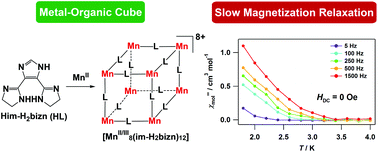Preparation of a magnetic metal–organic square and metal–organic cubes using 4,5-bis(2-imidazolinyl)imidazolate: slow magnetization relaxation behavior in mixed-valent octamanganese(ii/iii) clusters†
Abstract
Functional metal–organic squares (MOSs) and metal–organic cubes (MOCs) are important building units for zeolite-like metal–organic frameworks (ZMOFs), which are required to exhibit solid-state properties, such as dielectric, conductive, and magnetic properties. This work describes the preparation and magnetism of a tetracopper(II) macrocyclic complex [CuII4(im-H2bizn)4(DMSO)3(THF)](ClO4)4·8DMSO (1) (Him-H2bizn = 4,5-bis(4,5-dihydro-1H-imidazol-2-yl)imidazole) as a MOS and octametallic clusters [NiII8(im-H2bizn)12](ClO4)4·10MeOH·3H2O (2) and [MnII4MnIII4(im-H2bizn)12](ClO4)8·14MeOH (3) as MOCs. The CuII ion in 1 possesses a five-coordinated square pyramidal geometry, resulting in the formation of an M4L4-type square, which gives an estimated intramolecular antiferromagnetic interaction with an exchange coupling constant of JCu–Cu = −95 K. Meanwhile, 2 and 3 present six-coordinated octahedral geometries, giving M8L12-type cubes, of which 2 is a normal paramagnetic compound with intramolecular antiferromagnetic interactions, and where JNi–Ni = −32 K. The most notable compound 3 is a MnII4MnIII4 mixed valence state compound, which exhibits a slow magnetization relaxation behavior similar to that of single-molecule magnets. This is attributed to the contribution of magnetic anisotropy caused by the Jahn–Teller effect of the MnIII ions. Utilizing a modified Arrhenius plot to extract the values of the thermal barrier for magnetization reversal (Ea/kB) and the pre-exponential factor (τ0), the parameters for the relaxation behavior were estimated to be Ea/kB = 6.38 K and τ0 = 3.87 × 10−7 s. UV-vis spectroscopy and electrochemical measurements in solution were also carried out. Compound 3 will be expected to lead to a solid-state material in which the magnetic and dielectric properties of encapsulated small molecules cooperate with the slow magnetization relaxation properties of the MOC backbone.

- This article is part of the themed collection: Spotlight Collection: Metallocycles and Metallocages


 Please wait while we load your content...
Please wait while we load your content...